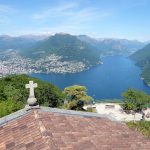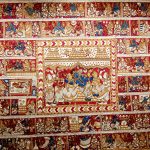Hello everyone! Today I’m gonna introduce to you the capital of canton Ticino in Switzerland – Bellinzona. There are direct trains going there from Zürich HB and it takes only 2 hours 16 mins.
1. The city and its three castles
The town lies east of the Ticino river, at the foot of the Alps. It stretches along the river valley, surrounded by the southern ranges of the Lepontine Alps to the east and west, and by the Lugano Prealps to the south. It’s famous for its three castles (Castelgrande, Montebello, Sasso Corbaro) that have been UNESCO World Heritage Sites since 2000.
These fortresses are among the finest examples of medieval fortification architecture in the alpine region. As they appear today, Bellinzona’s fortifications, whose origins actually go much further back to a prehistoric settlement on Castelgrande hill, are mainly the result of intensive and complex building activity undertaken by the Dukes of Milan in the 15th century.
1.1 Castelgrande
The site of the Castelgrande has been fortified since at least the late 1st century BC and until the 13th century it was the only fortification in Bellinzona. During its history the castle has been known as the stronghold (before the 13th century), the Old Castle in the 14–15th centuries, Uri Castle after 1506 and Saint Michael’s Castle from 1818. The Castelgrande hill includes a nearly vertical side on the north and a steep southern side, but is nearly flat and 150-200m in diameter. The natural shape of the hill has encouraged every man-made fortification to follow the same contours. Records from the 11th to 15th centuries as well as archeological evidence indicate that the castle grounds were once full of buildings. However most of these were pulled down by the Dukes of Milan to free up interior space. The open space was divided into 3 large baileys which served to provide temporary housing for troops that could be stationed in Bellinzona. Under the Dukes of Milan the outer fortifications were extended and strengthened. The walls were raised, extended and towers were added. The western walls were totally rebuilt and connected to the city walls. The castle can be reached by taking an elevator from the foot of the rock to the castle grounds or by climbing steep, narrow streets from the city center through the city wall onto the castle grounds.
For more info about opening hours and ticket prices of Castelgrande Museum please click here.
1.2 Montebello Castle
Montebello Castle (known as the Small, New or Middle Castle in the 15th century, as Schwyz Castle from 1506 and St. Martin’s Castle after 1818) is located to the east of the town center. It was built before 1313 for the pro-Imperial Rusca family, who occupied the castle following the Visconti victory and occupation of the Castelgrande. By the end of the 14th century it was in the hands of the Visconti. The castle was renovated and expanded between 1462 and 1490 to its current state. In the 19th century the castle fell into disrepair and was renovated starting in 1903. A little chapel, dedicated to Saint Michael, leans against the wall of the more recent south-facing section; built around 1600, it is one of the few buildings erected in the castles of Bellinzona under the rule of the three Swiss cantons.
Archaeological and Civic Museum
Montebello Castle houses the Archaeological and Civic Museum. The museum was opened in 1974 and is located in the tower and the former residential quarters of Montebello Castle. It is divided into two sections-history and archaeology. In the history section there are several capitals from the 15th century and a rare 13th-century Baptismal font as well as drawings and sketchs from several artists. This section also houses a collection of ceremonial and military arms. The archaeology section includes many items from 1400–1500 BC as well as ceramics, glassware, funeral urns, ornamental objects and jewellery in iron and bronze from around the canton. The museum is open from April to November.
For more info about opening hours and ticket prices of Montebello Castle Museum please click here.
1.3 Sasso Corsaro Castle
Sasso Corbaro, known as Unterwalden Castle after 1506 and Saint Barbara’s Castle after 1818, is about 600m south-west of town on a rocky hill. Unlike the other two castles Sasso Corbaro is not integrated into the city walls. The first part of the castle was the north-eastern tower which was built in 1478 to close a gap in the defenses of the city. The walls and south-west tower were added later. The castle was struck by lightning multiple times during the 16th and 17th centuries, and by 1900 was falling into ruins.
Museum
Today, Sasso Corbaro Castle houses the Sala Emma Poglia which is the “wooden room” built for the Emma family during the 17th century. Originally located in the entrance hall of their home in Olivone in the Blenio Valley, the room was purchased by the Canton of Ticino in 1944 and housed first in the Castelgrande before being moved to the Sasso Corbaro in 1989. The room is panelled entirely in walnut and also includes the stüva, stove which provided heating. The stove bears the crest of the Emma family (an eagle and a lion rampant). The museum also houses temporary exhibits. It is open from March until November.
For more info about opening hours and ticket prices of Sasso Corbaro Castle Museum please click here.
Some tips
The full ticket price for each castle museum is 5 CHF and you can buy a combined ticket for all three museums for 15 CHF. If you wanna know discounted prices please click the links I give above for more info. The opening hours and ticket prices I mentioned above are about castle museums. However, Basically all the three castles are open from
- April – June / September – October, Monday – Sunday 10.00 – 18.00
- July – August, Monday – Sunday 10.00 – 19.00
You can choose to talk between the three castle or take a bus (No.4). However, the bus is very infrequent (every 1-4 hours). To walk from the lowest castle to the top one takes around 50 mins and you will pass the middle one, Montebello Castle. Maybe you can choose one way by foot and the other way by bus.
2. Ponte Tibetano Carasc
First of all, you need to take a bus from Bellinzona to bus top Monte Carasso, Urènn/Funivia. From there you need to walk ahead for around 3 mins and you will see the cable car station. You can either buy the tickets from a ticket machine or ticket office. The normal price is 19 CHF round way from the bottom to top. Thanks to the Monte Carasso-Mornera cableway, the ancient and picturesque hill town of Curzútt is the ideal starting point to discover this offer or for a gastronomic stop after this thrilling experience. If you wanna go to Ponte Tibetano Carasc, get off at the middle stop Curzútt and walk around 1 hour to reach it.
2.1 On the way
- For more info about different ticket prices please click here.
- For more info about operation hours (and time for lifts reserved for transport of service staff), please click here.
- The cable car can only take 8 person at one time so you might need to wait in the line to get on.
2.2 San Barnárd church
One small tip, on your way to the bridge, don’t forget to check the San Barnárd church, at an altitude of 600 m. It is part of a group of ancient monuments located in Monte Carasso that are of unique national importance (category A) to the Bellinzona area. Far from the main highway and reachable only by cable car or by foot, this important monument is not well known and rarely visited. Surrounding this church (whose frescoes are still discreetly conserved after the 1970’s restorations) are the ancient hamlets where residents of Monte Carasso lived until 1700. The lady in the church will explain to you about the church and when you leave she will do a survey and give you an introduction of the church with a payment slip in it for donation. She didn’t give it to me maybe because she thinks I’m just traveling in Switzerland so I don’t have a swiss card, but make the donation or not still totally depends on you. Anyway, the church is nice. If you wanna know more about the church please click here.
2.3 The suspension bridge
The 270 m long Tibetan bridge built by the Foundation Curzútt-S. Barnard becomes the passage of the rugged valley that separates the communities of Sementina and Monte Carasso, two towns located in front of Bellinzona. The bridge connects the stone made village – Curzútt to the hiking path of “Via delle Vigne”, allowing you to make excursions in an area characterized by a landscape rich in cultural heritages.
Anchored at a height of 696 m, the bridge rises 130 m above the ground. The walkway is made of larch wood. Crossing it is a unique experience as well as a true challenge. However, don’t worry, it’s definitely risk-free.
3. Mornera
If you wanna have walk on the top of the mountain you can keep going from Curzútt to Mornera (1400m). For me, this mountain was actually nothing special. However, I did love the view from Curzútt to Mornera in the cable car while you “fly” over huge amount of chestnut trees. The park on top of the mountain is nice but I feel it looks similar to other mountains, so if you don’t have enough time, it won’t be a big pity to just go to Curzútt and return. However, I’ll show you some pics of what it looks like on the top and on my way back so you can decide by yourself.
If you are a fan of castles, mountains, hiking or thrilling suspension bridges, I believe you will have a good day in Bellinzona. 🙂
























































































